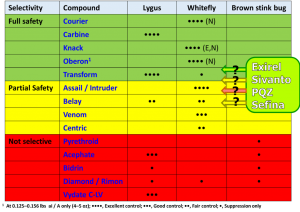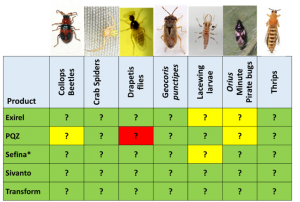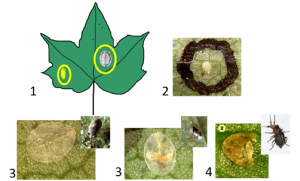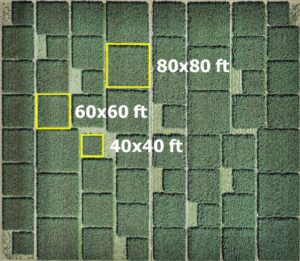Final report for GW18-131
Project Information
Our project is empowering growers to make more sustainable management decisions through research on the effects of currently registered and experimental whitefly, Bemisia tabaci, and Lygus bug insecticides on natural enemies, and investigating the effect of plot size in this type of study—plots that are too small fail to accurately measure effects because insects move too freely between plots; plots that are too large become too expensive to run or too variable in other factors across a field. We conducted a non-target organism trial in cotton in Arizona, and we examined selectivity of recently registered insecticides and effects of plot size on population dynamics and predation rates of whitefly natural enemies in cotton. We sampled pests and natural enemies using established methods, and examined predation rates. Our observations to date have indicated that some of the insecticides tested appear to be very selective towards our key natural enemies in cotton, and other insecticides seem to be harmful to some of them. We have been teaching producers about the role of our key natural enemies, the benefits of choosing selective insecticides and conservational biological control, the research methods that support this project, and our preliminary results on the selectivity of the candidate insecticides. Once our data analyses are finalized, we will determine which compounds are compatible with our sustainable IPM plan, and will revise our insect management guidelines. Surveys conducted at producers’ meetings have indicated that PCAs and growers recognize the value of natural enemies and that biological control affects their decisions of opting for selective insecticides.
Our goals were to develop better information about the effect of currently registered and
experimental whitefly, Bemisia tabaciMiddle East-Asia Minor 1 (MEAM1), and Lygus bug, Lygus hesperus,insecticides on non-target organisms (NTOs), i.e., natural enemies, and to investigate the effect of plot size on the biocontrol function and density of natural enemies in NTO studies. We expect that the data from this project will assist cotton growers in selecting
insecticides that minimize disruption of natural enemies and will also improve scientific
interpretation of NTO data for mobile insects in future research studies. The objectives were:
1) To test the selectivity and efficacy of currently registered and experimental
insecticides towards natural enemies of whitefly (and other pests) in cotton.
2) To investigate the effects of plot size on population dynamics and biocontrol function
in non-target organism studies.
3) To enhance growers’ knowledge of insecticide selectivity, and teach them about the
selectivity of candidate insecticides while promoting the benefits of using selective
insecticides for a sustainable cotton production through our Educational Outreach Plan.
Cooperators
- (Researcher)
- (Educator)
- (Educator)
Research
Objective 1: To test the selectivity and efficacy of currently registered and experimental insecticides on the main natural enemies of whitefly (and other pests) in cotton.
We conducted a field trial, as described in the proposal, to develop information about the selectivity of currently registered and experimental whitefly and Lygus bug insecticides on natural enemies in cotton.
We tested the effects of two newly registered insecticides used in cotton in Arizona (cyantraniliprole and flupyradifurone), and two insecticides that were experimental, but became registered in our state in 2019 (pyrifluquinazon and afidopyropen). We sampled the densities of natural enemies, whiteflies and Lygus bugs prior to and after insecticide application.
Objective 2: To investigate the effects of plot size on population dynamics and biocontrol function in non-target organism studies.
We established three different plot sizes in field studies: 80 by 80 feet (0.059 ha), 60 by 60 feet (0.033 ha), and 40 by 40 feet (0.015 ha). The number of natural enemies samples taken varied according to plot size.
We used an in situ sentinel prey method to measure biocontrol function. We identified and documented sources of mortality and prey removal of whitefly nymphs and eggs by natural enemies in the field.
In this project, we studied insecticides to determine if they were safe to beneficial insects in our cotton system, and plot sizes that could realistically represent what happens to these beneficial insects when insecticides are sprayed in commercial fields. Making this information available to growers will help them to avoid costly investments in products that are incompatible with our insect management system, which is based on insecticide efficacy and conservation of beneficial insects, saving them considerable costs while better supporting ecosystem services. Studying plot sizes is important to ensure that we are reliably testing the effects of insecticides on beneficial insects, and providing accurate, actionable information to growers in Arizona.
This project allowed us to test the selectivity of novel and experimental insecticides to provide more informed pest management decisions to growers. We are now aware of which of the currently registered insecticides appear to be safe to natural enemies in our cotton system, and this will help producers to conserve beneficial insects in their fields. We have observed compounds that are very selective towards our key natural enemies, and others that might harm some of them. Two of the insecticides tested, PQZ and Sefina, were registered in 2019, and we will be able to teach growers and pest control advisers (PCAs) of their impacts on natural enemies and their fitness to our IPM program right at product launch. We will review and revise our insect management guidelines, which are based on insecticide selectivity, and include the registered insecticides tested in each category of selectivity: fully selective, partially selective and broad-spectrum (Figure 1).
Our observations to date have indicated the selectivity of each candidate chemistry relative to key natural enemies in the cotton system (Figure 2). These are the natural enemies which are most influential on the food web in cotton, and they are also part of natural enemies “thresholds” previously developed to aid in spray decisions, and which we have recently introduced to growers and PCAs. These key natural enemies vary in abundance according to location and time of the year. By following the sampling guidelines for these natural enemies thresholds, growers and PCAs are able to verify which natural enemies are mostly available in each location at each time of the year. Our results will provide them with an even more refined and comprehensive spray decision, because based on the natural enemies mostly present in their fields, they will be able to choose, among the novel insecticides, the ones that are less harmful or benign to the natural enemies in question.
The approaches used in this trial will serve as the basis for other non-target research we will are conducting and teaching about to producers. For example, we developed a methodology to measure biocontrol function in this project (a parameter that measures the predation rates and sources of mortality caused by natural enemies) and learned which improvements need to be deployed. As many insecticides now do not kill some species outright, this approach measures the direct outcome of biological control. This avoids the pitfall of relying solely on natural enemy abundance data when some insecticides might be having sublethal effects on natural enemies and impact their function (e.g., feeding behavior). We will use this methodology to assess non-target effects in another trial testing a new genetically modified cotton with a trait designed to control Lygus bugs and thrips. Our approach is based on the use of in-field, sentinel prey. Whiteflies are a permanent fixture of the Arizona cotton system and are a common food source for many natural enemies. The rate at which sentinel prey are removed from the system tells us how well biological control is functioning (Figure 3).
We also investigated plot sizes that could realistically represent what happens to non-target organisms in commercial fields (Figure 4). These results will be the basis for future non-target organism trials, including the one described above. Our cooperators from private companies have emphasized the relevance of this work for regulatory purposes. Whenever protocols are developed to test crop traits, there is worldwide debate, limited literature, and much uncertainty about which plot sizes should be used to assess non-target organism effects of pesticides. Hopefully, our data, still under analyses, will help us reach a conclusion for the Arizona cotton system, produce new knowledge on plot size effects generally, and determine which specific insecticides tested could be useful in other cropping systems. If our data are inconclusive in this regard, we will use data from this project to apply for another grant to support this fundamental question.
Companies that produce and sell insecticides are more willing to support and promote our efficacy trials than non-target organisms (NTOs) trials—these directly support their needs for demonstrating target pest control. However, producers are able to make better pest management decisions when data on insecticide safety towards natural enemies is also available. This project has stimulated more company participation in our NTO trials. For example, a company previously disinterested in our trial has become interested in supporting future NTO studies. There have also been two different additional companies interested in non-target testing in 2019. This is an important behavior change we attribute to the quality of our research and to our education efforts.
Our data analyses are underway, and we already have some preliminary results, especially for objective 1. Our next steps will be to finalize our data analyses and review our insect management guidelines by adding candidate insecticides to the selectivity category they belong to (Figure 1), and to continue our educational outreach throughout the year. This grant is part of the thesis of a Masters student. She will finalize her results and thesis this year. Afterwards, she will continue to help with the remaining Extension work, and publish her results in scientific journals.

Figure 1.The IPM plan offers this guideline to growers and PCAs. Insecticides are categorized according to their selectivity towards natural enemies and target pest efficacy. Through this project, we expect to determine how to categorize the candidate insecticides (Exirel, Sivanto, PQZ and Sefina).

Figure 2.Preliminary results for individual species abundance only. Green: strong indication that the insecticide might be safe to the natural enemy; yellow: some indication that the insecticide might be harmful to the given natural enemy; red: strong indication that the insecticide might be harmful to the given natural enemy. ‘?’, results not finalized.This table isan example of what we will be sharing with growers.*1-year’s data only.

Figure 3.We were able to determine the source of predation based on the marks left by natural enemies on whitefly nymphs and eggs after feeding. 1: large nymph and eggs of whitefly marked on cotton leaf (not to scale). 2: large nymph marked with a circle. 3 & 4 evidence of predation left by sucking and chewing predators, respectively. Credits: Peter Ellsworth (UofA) and Steve Naranjo (USDA).

Figure 4. Field trial with three different plot sizes. Some insects are highly mobile and their movement and distribution among plots could mask the effects of insecticides, especially if a plot is too small. Credits: Kapil Khanal and Naomi Pier (UofA).
Research Outcomes
Education and Outreach
Participation Summary:
Objective 3: To enhance growers’ knowledge of insecticide selectivity, and teach them about the selectivity of the candidate insecticides while promoting the benefits of using selective insecticides for a sustainable cotton production through our Educational Outreach Plan.
Prior to the initiation of this project, we formed an advisory committee including one grower and three licensed Pest Control Advisors (PCAs). In Arizona, PCAs are highly educated and experienced pest management consultants employed by growers (farmers) to provide expertise in insect, weed and disease management. In most cases, PCAs are the primary decision makers on pest management for the growers*. As such, they provide a key target audience for this project. Because each PCA usually works with multiple growers, education targeting PCAs has the effect of multiplying our outcomes by impacting thousands of acres with the decisions they make. Our advisory committee members have been instrumental in discussing and approving our research design and project plan. They received a collection of pinned natural enemies and a book about the natural enemies of the Southwest in consideration of their important project contributions. We have asked them to sample natural enemies prior to and after insecticide applications in their commercial fields, in order to qualitatively validate the project research, while giving producers an experiential understanding of natural enemies in their commercial fields and the impact of insecticides on them. They have attended our Extension meetings, and they will review our Extension publication when we produce it.
Our Educational Outreach Plan was fully integrated into our ongoing Extension outreach program, which includes presentations, workshops and field days. We have been teaching and motivating growers and pest control advisers about general trends of the industry to make cotton production even more sustainable and with fewer impacts on the environment. Our Extension work with producers included reviewing our insecticide history and how the use of broad-spectrum insecticides was harmful for the cotton ecosystem, and its economic and environmental implications that resulted in high number of sprays in the past in Arizona. We contrasted these events by showing that the inclusion of selective approaches, including insecticides, contributed to the conservation of natural enemies in the system and to the drastic reduction in the number of sprays, which currently averages 2 sprays per season for all arthropods. Showing our spray history is essential to educate young growers and PCAs that were not exposed to the problems caused by broad-spectrums and the lack of conservation of natural enemies. Along with that, we showed whitefly outbreaks around the United States and the world, and the reasons that explain why those IPM plans are unstable.
We also taught producers how selective chemistries conserve natural enemies and allow them to outweigh pest numbers and promote pest control for long periods of time in our system. We also showed our key natural enemies and explained how our new “natural enemies” thresholds aid in spray decisions. We educated our producers about the in-field mortality that is caused by these natural enemies, and therefore the importance of conserving them through the use of selective insecticides. We explained the research methods that are deployed to determine whether insecticides are selective or are impacting natural enemies function and survival. We have been sharing our preliminary results on the selectivity of the candidate insecticides we tested, and which natural enemies they might impact on.
We measured increases in knowledge and intention to adopt our teachings from this project in seven Extension meetings. Our audience began with an already high level of understanding as a result of their own education through our ongoing Extension program. 86% of participants (n = 44) reported an increase in knowledge of the research methods used to understand the relative selectivity of insecticides after our presentations in three meetings. 72% of growers and PCAs (n = 92) indicated an increase in knowledge of insecticide selectivity and its role in conserving natural enemies as a result of our training. 93% of participants (n = 97) indicated that it was likely that this research on insecticide selectivity will influence their decisions on future insecticide applications. Out of those, 62% suggested it was extremely likely to influence their decisions. 64 respondents at six meetings estimated the economic value of conservation biological control (conserving predators) in cotton at an average of $85 per acre. These results suggest that PCAs and growers recognize the value of natural enemies and that biological control affects their decisions of opting for selective insecticides. For context, one whitefly or Lygus spray costs cotton growers on average about $28.84 or $24.54 per acre, respectively; overall insect control input costs inclusive of scouting and seed technologies are around $111 per acre (Ellsworth, Cotton Pest Losses data).
This project’s Educational outreach was included in our standard Extension meetings throughout Arizona, which typically included a mix of growers and PCAs (75% of attendees) and others (25%). Within that context, we presented project information on selective insecticides, including a preliminary draft of our forthcoming Extension Bulletin, which will be an outcome of this project. Finally, we have included numbers from five summer meetings in northern Mexico (Sonora and Chihuahua), reaching cotton growers and technicos, highly trained pest management professionals that function similarly to our PCAs in Arizona, providing advice and pest management decision support to growers.
As of this reporting, we have taught growers, PCAs and others in the Extension meetings below. This list includes Extension meetings related to or about this research, but not always the sole focus of each presentation.
*Note: Because PCAs are pest management decision-makers for farmers, their numbers are included in the next section of this report in questions related to changes in knowledge and behavior. The surveys were applied in seven meetings, in which the audience began with an already high level of understanding, and there were up to 97 respondents in total for all seven meetings (number of respondents varied according to each question).
04/17/2018. Ellsworth, P.C. Conservation Biological Control in Arizona Cotton. Xerces Society meeting. Tucson, AZ. 1.0 AZ CEUs. 25 participants. (INVITED)
05/09/2018. Ellsworth, P.C. New Research & Trends in Cotton Insect Control. Desert Agriculture Conference. Ft. McDowell, AZ. 0.6 AZ CEUs. 250 participants. (INVITED)
5/16-17/2018. Ellsworth, P.C. & A.J. Fournier. Arizona IPM Program Update. 2018 WERA-1017 Annual Meeting. Portland, OR. 26 participants
5/18/2018. Ellsworth, P.C. Pesticide Risk Reduction in Cotton & Reducing Impacts on Non-Target Organisms. Pesticide Risk Reduction Workgroup meeting. Portland, OR. 22 participants
05/24/2018. Ellsworth, P.C. Cotton IPM. Pest Management Training for Growers, Sponsored by Dow Mexico. Mexicali, Mexico. 80 participants. (2.5 hours) (INVITED)
06/01/2018. Ellsworth, P.C. Doing No Harm: Cotton IPM, a Review of Insect Control Practices. Yuma Tent Talk. Yuma Agricultural Center, Yuma, AZ. 20 participants. 0.6 AZ CEU.
06/06/2018. Ellsworth, P.C., I. Bordini, S.E. Naranjo, A.J. Fournier. Hard and Soft Technologies Support Successful Insect Management in Cotton. Fifth Annual New Technologies Workshop. Maricopa Agricultural Center, Maricopa, AZ. 56 participants. 0.6 AZ CEU.
06/12/2018. Ellsworth, P.C., Cotton IPM Evening Seminar. Mexicali, Sonora, Mexico. 1.5 h; 100 participants. (INVITED)
06/12/2018. Ellsworth, P.C., Cotton IPM Field Workshops. Mexicali, Sonora, Mexico. 50 participants. (INVITED)
06/27/2018. Ellsworth, P.C., Cotton IPM Evening Seminar. El Oasis, Ojinaga, Chihuahua, Mexico. 50 participants. (INVITED)
06/28/2018. Ellsworth, P.C., Cotton IPM Field Workshops. El Oasis, Ojinaga, Chihuahua, Mexico. 30 participants. (INVITED)
06/28/2018. Ellsworth, P.C., N. Pier, I. Bordini. Insect IPM in Cotton. Cotton "Tent Talks". A Tumbling T Ranches, Goodyear, AZ. 27 participants. 0.6 AZ CEU.
07/25/2018. Ellsworth, P.C., I. Bordini, N. Pier. Cotton IPM Updates. Cotton "Tent Talks". John Walker's Farm, Casa Grande, AZ. 19 participants. 0.6 AZ CEU.
07/26/2018. Ellsworth, P.C., I. Bordini, N. Pier. Cotton IPM Update. Cotton "Tent Talk". Pacheco's Farm, Marana, AZ. 9 participants. 0.6 AZ CEU.
08/07/2018. Ellsworth, P.C., I. Bordini, N. Pier, S.E. Naranjo. Cotton IPM. Cotton Incorporated Tour, Maricopa, AZ. 6 participants.
10/03/2018. Ellsworth, P.C., I. Bordini, N. Pier. Bt Cotton and Insecticides for Lygus and Whiteflies and Their Impacts on Beneficials. The 8th Annual Central Arizona Farmer Field Day. Maricopa Agricultural Center, Maricopa, AZ. 71 participants. 1.6 AZ CEUs.
01/10/2019. N. Pier., I. Bordini, P.C. Ellsworth. Measuring Biological Control for Whiteflies. Marana Health Clinic, Marana, AZ. 20 participants. 0.5 AZ CEU.
01/15/2019. Ellsworth, P.C, N. Pier, I. Bordini, A.J. Fournier. Measuring Biocontrol of Whiteflies. Winter Field Crops Clinic. The Property, Casa Grande, AZ. 35 participants. 0.5 AZ CEU.
01/16/2019. Ellsworth, P.C, N. Pier, I. Bordini, A.J. Fournier. Measuring Biocontrol of Whiteflies. Winter Field Crops Clinic. Elk’s Lodge, Buckeye, AZ. 37 participants. 0.5 AZ CEU
2/6/2019. N. Pier., I. Bordini, P.C. Ellsworth. Measuring (& Using!) Biological Control for Pest Management. Winter Field Crops Clinic. Southeastern Arizona Farm & Ranch Trade Show. Willcox Community Center, AZ. 0.6 AZ CEU's. 30 participants.
2/8/2019. N. Pier., I. Bordini, P.C. Ellsworth. Measuring (& Using!) Biological Control for Pest Management. Farm Home Ranch Day. Eastern Arizona College Activity Center, Safford, AZ. 0.6 AZ CEU's. 35 participants.
2/21/2019. I. Bordini., P.C. Ellsworth, N. Pier.Selective Insecticides and Biological Control for Pest Management. Southwest AG Summit. Arizona Western College, Yuma, AZ. 0.8 CEU’s. 8 participants.
5/8/2019. Ellsworth, P.C, I. Bordini, N. Pier, A.J. Fournier.Measuring (& Using!) Biological Control of whiteflies. Desert Agriculture Conference. Wild Horse Pass Resort & Casino, Chander, AZ. 0.6 CEU’s. 100 participants.
5/16/2019. Ellsworth, P.C, I. Bordini, N. Pier, A.J. Fournier.Measuring (& Using!) Biological Control of whiteflies. Progressive Farmers. Riverside County Blythe Satellite Office, Blythe, AZ. 1.0 CEU’s. 35 participants.
We will continue our Extension work throughout 2019, attending other Extension Meetings and updating growers and PCAs about our results.
The two Field Crop IPM Shorts (Extension publications)* related to this work were produced, distributed in meetings, and made available online. We will also produce at least one Extension publication (updated IPM guidelines) once our data analyses are finalized, and we will distribute it in Extension meetings to growers and PCAs. All educational material will be available online.
We anticipate publication of a journal article to share the results of this project with scientific colleagues and encourage similar approaches in other systems. This will be completed after the termination of project.
Extension Publications
Ellsworth, P.C., N. Pier, A.J. Fournier, S.E. Naranjo, T. Vandervoet. 2019. Predator “Thresholds”.
University of Arizona Cooperative Extension IPM Short.
http://cals.arizona.edu/apmc/docs/PredatorThr esholds.pdf
Vandervoet, T., P.C. Ellsworth, L.M. Brown, A.J. Fournier, S.E. Naranjo. 2019. Making Whitefly
and Predator Counts. University of Arizona Cooperative Extension IPM Short.
https://cals.arizona.edu/crop/cotton/files/PredatorToPreyRatios.pdf